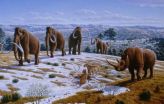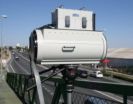(Press-News.org) Palo Alto, CA—Using sophisticated airborne imaging and structural analysis, scientists at the Carnegie Institution's Department of Global Ecology mapped more than 40,000 termite mounds over 192 square miles in the African savanna. They found that their size and distribution is linked to vegetation and landscape patterns associated with annual rainfall. The results reveal how the savanna terrain has evolved and show how termite mounds can be used to predict ecological shifts from climate change. The research is published in the September 7, 2010, advanced online edition of Nature Communications.
Mound-building termites in the study area of Kruger National Park in South Africa tend to build their nests in areas that are not too wet, nor too dry, but are well drained, and on slopes of savanna hills above boundaries called seeplines. Seeplines form where water has flowed belowground through sandy, porous soil and backs up at areas rich in clay. Typically woody trees prefer the well-drained upslope side where the mounds tend to locate, while grasses dominate the wetter areas down slope.
"These relationships make the termite mounds excellent indicators of the geology, hydrology, and soil conditions," commented lead author Shaun Levick at Carnegie. "And those conditions affect what plants grow and thus the entire local ecosystem. We looked at the mound density, size, and location on the hills with respect to the vegetation patterns."
Most research into the ecology of these savannas has focused on the patterns of woody trees and shorter vegetation over larger, regional scales. Work at the smaller, hill-slope scales has, until now, been limited to 2-dimensional studies on specific hillsides. The Carnegie research was conducted by the Carnegie Airborne Observatory (CAO)–a unique airborne mapping system that operates much like a diagnostic medical scan. It can penetrate the canopy all the way to the soil level and probe about 40,000 acres per day. The CAO uses a waveform LiDAR system (light detection and ranging) that maps the 3-dimensional structure of vegetation and, in this case, termite mounds and combines that information with spectroscopic imaging—imaging that reveals chemical fingerprints of the species below. It renders the data in stunning 3-D maps.
"We looked at the vegetation and termite mound characteristics throughout enormous areas of African savanna in dry, intermediate, and wet zones," explained Levick. "We found that precipitation, along with elevation, hydrological, and soil conditions determine whether the area will be dominated by grasses or woody vegetation and the size and density of termite mounds."
The advantage of monitoring termite mounds in addition to vegetation is that mounds are so tightly coupled with soil and hydrological conditions that they make it easier to map the hill slope seeplines. Furthermore, vegetation cover varies a lot between wet and dry season, while the mounds are not subject to these fluctuations.
"By understanding the patterns of the vegetation and termite mounds over different moisture zones, we can project how the landscape might change with climate change," explained co-author Greg Asner at Carnegie. "Warming is expected to increase the variability of future precipitation in African savannas, so some areas will get more, while others get less rain. The predictions are that many regions of the savanna will become drier, which suggests more woody species will encroach on today's grasslands. These changes will depend on complex but predictable hydrological processes along hill slopes, which will correspond to pattern changes in the telltale termite mounds we see today from the air."
INFORMATION:
This research was funded by a grant from the Andrew Mellon Foundation. The Carnegie Airborne Observatory is supported by the W.M. Keck Foundation and William Hearst, III. SANParks provided logistical support.
The Carnegie Institution for Science (carnegieScience.edu) has been a pioneering force in basic scientific research since 1902. It is a private, nonprofit organization with six research departments throughout the U.S. Carnegie scientists are leaders in plant biology, developmental biology, astronomy, materials science, global ecology, and Earth and planetary science.
Only 45 percent of the 354 million annual visits for acute care in the United States are made to patients' personal physicians, as Americans increasingly make busy emergency departments, specialists or outpatient care departments their first point of contact for treatment of new health problems or a flare up of a chronic condition like asthma or diabetes.
The findings, which appear in the September edition of Health Affairs, do not bode well for the nation's already busy and frequently undermanned emergency rooms. While fewer than five percent of doctors across the ...
UPTON, NY — A brain-scanning study at the U.S. Department of Energy's (DOE) Brookhaven National Laboratory, conducted with collaborators from Stony Brook University, reveals that an oral dose of methylphenidate, commonly known as Ritalin, improves impaired brain function and enhances cognitive performance in people who are addicted to cocaine. The study — to be published in the Proceedings of the National Academy of Sciences the week of September 6, 2010 — suggests that methylphenidate, combined with cognitive interventions, may have a role in facilitating recovery from ...
A team made up of members of the University of Oviedo (UO) and the Complutense University of Madrid (UCM) have gathered together all findings of the woolly mammoth, the woolly rhinoceros and the reindeer in the Iberian Peninsula to show that, although in small numbers, these big mammals, prehistoric indicators of cold climates, already lived in this territory some 150,000 years ago.
The presence of the woolly mammoth (Mammuthus primigenius), the woolly rhinoceros (Coelodonta antiquitatis), the reindeer (Rangifer tarandus), and to a lesser extent the wolverine (Gulo gulo), ...
Researchers have developed a new data transmission system that could substantially improve the transmission capacity and energy efficiency of the world's optical communication networks.
Transmission of data through optical networks is currently limited by 'phase noise' from optical amplifiers and 'cross talk' induced by interaction of the signal with the many other signals (each at a different wavelength) simultaneously circulating through the network. 'Phase noise' is the rapid, short-term, random fluctuations in the phase of a signal, which affects the quality of the ...
A new study from Sweden's Karolinska Institutet suggests that bipolar disorder – or manic-depressive disorder – does not increase the risk of committing violent crime. Instead, the over-representation of individuals with bipolar disorder in violent crime statistics is almost entirely attributable to concurrent substance abuse.
The public debate on violent crime usually assumes that violence in the mentally ill is a direct result of the perpetrator's illness. Previous research has also suggested that patients with bipolar disorder – also known as manic-depressive disorder ...
PHILADELPHIA, PA. (September 7, 2010)—Aurora-A kinase (AurA) is an enzyme that is hyperactive in many cancers and drives tumor cell proliferation. Several AurA inhibitors are currently being tested in clinical trials to see if they slow tumor growth. Now, researchers in the Developmental Therapeutics Program at Fox Chase Cancer Center have identified an activation signal for AurA. They report in the September 7 issue of Nature Communications that a quick increase in the calcium concentration in a cell rapidly triggers AurA kinase activity. The discovery may lead to drug ...
The methodology, which has been used in this research in collaboration with the Universidad Europea de Madrid, is based on the Open-Path FTIR technique which takes advantage of specific properties of gases in order to detect them: they absorb radiation only in certain wave lengths which are always the same and particular to each gas. Many gases have absorption lines or bands in the infrared, for which this area of the electromagnetic spectrum is very useful for the remote detection of gases, according to the authors of this research from the UC3M Department of Physics. ...
The first entire genome of an Irish individual has been sequenced. The sequence is reported in BioMed Central's open access journal, Genome Biology and provides insight into the evolutionary history of this distinct lineage.
Led by Professor Brendan Loftus, the research team from UCD Conway Institute used data from a previous genotyping study to select a suitable Irish male representative for sequencing. Then, using pair- and single-ended Illumina short read sequencing, one of the next generation sequencing approaches, the team created 9 DNA sequence libraries, which ...
ESA's GOCE gravity mission has recovered from a glitch that prevented the satellite from sending its flow of scientific data to the ground. News of the recovery comes earlier than expected, thanks to the fervent efforts of a team of experts.
The recovery follows a serious communications malfunction on 8 July, when the Gravity field and steady-state Ocean Circulation Explorer (GOCE) satellite suddenly failed to downlink scientific data to its receiving stations.
Extensive investigations by experts from ESA and industry revealed that the issue was almost certainly related ...
Using a moving 3D computer model based on the skull and teeth of a New Zealand reptile called tuatara, a BBSRC-funded team from the University of Hull, University College London and the Hull York Medical School has revealed how damage to dental implants and jaw joints may be prevented by sophisticated interplay between our jaws, muscles and brain. This research will appear in a future edition of the Journal of Biomechanics.
The tuatara is a lizard-like reptile that has iconic status in its homeland of New Zealand because its ancestors were widespread at the time of the ...


